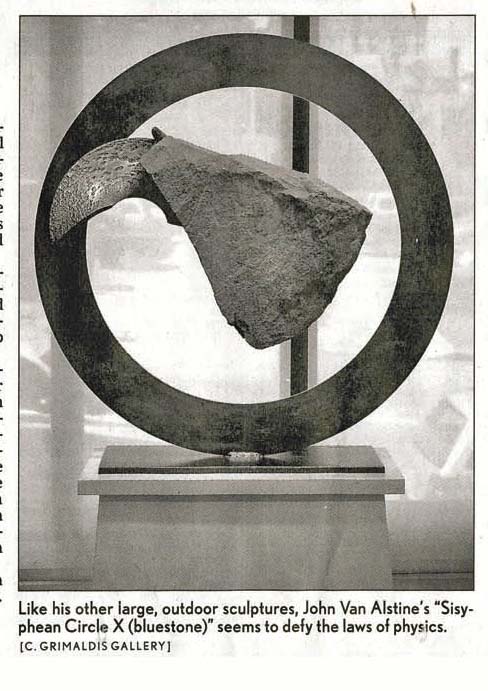

Summer
at Grimaldis
Art: Glenn McNatt
Sculptures are as interesting the second time around
Art Column
Originally published Jun 14, 2006
The summer sculpture show at C. Grimaldis gallery presents a half-dozen artists
who have had solo exhibitions at the venue over the past two years and whose
return as a group offers gallery patrons an opportunity to revisit some of the
highlights of previous seasons.
Grimaldis introduced Baltimoreans to German artist Annette Sauermann's luminous
wall-relief sculptures in 2004, when her series of rectangular cast concrete
blocks linked by thin, translucent sheets of white plastic film were first shown
at the gallery.
Sauermann's minimalist pieces from that period were as elegant as a painting
by Mondrian, but they also seemed somewhat severe in character, owing to the
absence of color in her mostly black (or gray)-and-white forms.
In the current work, the artist has retained the geometric grid of her earlier
pieces, but she also has introduced a surprising new element of color in the
form of Plexiglas sheets in primary hues that noticeably brighten the compositions
and heighten their impression of luminosity.
Every time I see Anthony Caro's angular, abstract painted steel sculptures,
I find myself a little more convinced of this English artist's importance as
a modernist innovator.
Caro's vigorous forms recall the influence American abstract-expressionist painting
had on artists around the world. Just as the Ab-Exers gave painters license
to experiment with new forms and techniques, Caro's rusted and varnished works,
with their suggestion of primitive energy and color, enlarged the formal language
of 20th-century sculpture in the postwar era.
The two "table pieces" on view at Grimaldis, created 10 years apart
in the mid-1970s and '80s, were each in their way daring for the time, and today
they look as fresh and vital as ever.
In previous reviews I have described
John Van Alstine's heavy, stone-and-steel outdoor sculptures, whose huge elements
seem to float weightlessly in defiance of the laws of physics, as representations
of arrested motion, as metaphors for the precarious balance that constitutes
all life and as abstract desert and mountain landscapes.
None of these descriptions seems completely satisfying; there's a potent aura
of mystery and ambiguity in his best sculptures -- like the stunning Sisyphean
Circle X (bluestone) in the current show -- that resists being reduced to a
single formulation, which is probably as it should be.
There's no real benefit to be derived anyway from too close critical interpretation
of these visually impressive pieces; if they manage to provoke wonderment and
joy in the viewer, as they surely do, one can say the artist has done his job.
Jon Isherwood's equally mysterious marble sculptures are modeled on plaster
casts that have been translated into three-dimensional digital files. The files
control a robotic lathe that actually fabricates the pieces, which resemble
primitive vessels and containers or the swelling female forms of Stone Age sculpture.
The artist applies the finishing touches by hand when he polishes the stone.
Japanese sculptor Osami Tanaka's lovely, post-minimalist pedestal of paraffin,
beeswax and steel has been shown in the gallery before, and it's a delight to
see it again.
I have not, however, much altered my opinion of sculptor John Ruppert's bronze
and iron casts of stones, which I once described as "a somewhat mannered
commentary on the relationship between art and nature and our ability to perceive
the difference between them ... a strategy that owes a lot to certain French
poststructural critical theorists but doesn't mean much outside that rarefied
context."
A Sculpture Show runs through July 12 at C. Grimaldis, 523 N. Charles St. Call
410-539-1080.
Copyright © 2006, The Baltimore Sun | Get Sun home delivery